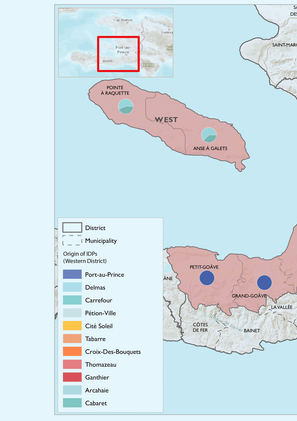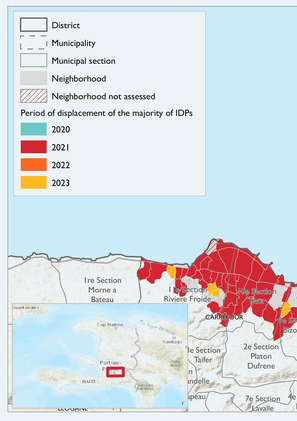-
Countries
-
Data and Analysis
-
Special Focus
-
Crisis Responses
Country
IDPs tracked
Displacement Movements
No figure is available
IDMC 2023
Data collection round
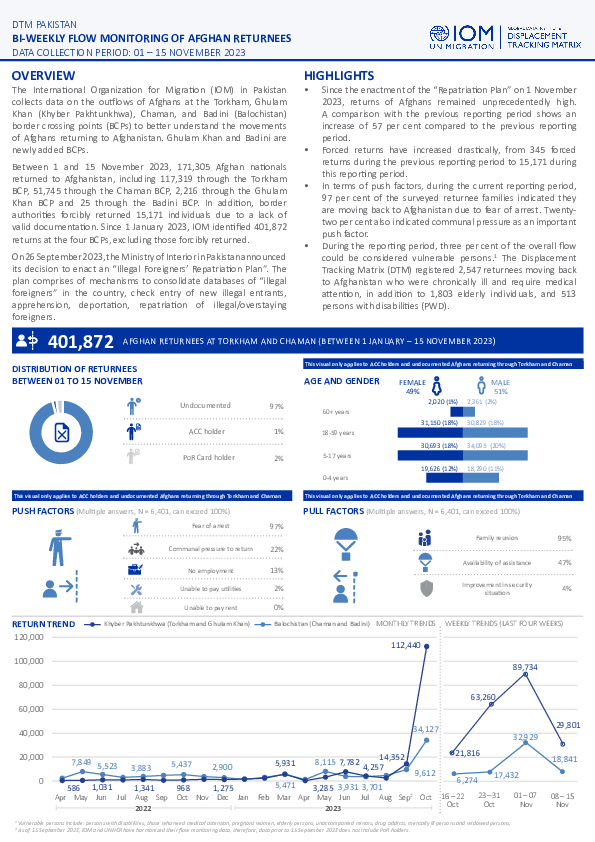
Contact
DTM Pakistan, iomisbdtmremapteam@iom.int
Language
English
Location
Pakistan
Period Covered
Nov 01 2023
Nov 15 2023
Activity
- Flow Monitoring
The International Organization for Migration (IOM) in Pakistan collects data on the outflows of Afghans at the Torkham, Ghulam Khan (Khyber Pakhtunkhwa), Chaman, and Badini (Balochistan) border crossing points (BCPs) to better understand the movements of Afghans returning to Afghanistan. Ghulam Khan and Badini are newly added BCPs.
Between 1 and 15 November 2023, 171,305 Afghan nationals returned to Afghanistan, including 117,319 through the Torkham BCP, 51,745 through the Chaman BCP, 2,216 through the Ghulam Khan BCP and 25 through the Badini BCP. In addition, border authorities forcibly returned 15,171 individuals due to a lack of valid documentation. Since 1 January 2023, IOM identified 401,872 returns at the four BCPs, excluding those forcibly returned.

Contact
DTM Europe, DTMMediterranean@iom.int
Language
Bosnian, Croatian, Serbian
Location
Serbia
Period Covered
Oct 04 2023
Oct 19 2023
Activity
- Survey
- Flow Monitoring
- Migrants presence
Ovaj izveštaj pruža uvid u profile, iskustva i putovanja Sirijskih državljana koji su u tranzitu u Republici Srbiji. Podaci su prikupljeni od 4. do 19. oktobra 2023. zajedno s Komesarijatom za izbeglice i migracije Republike Srbije (KIRS).
IOM je intervjuirao 103 sirijska državljana u pet prihvatnih centara (TC Sombor, TC Preševo, AC Krnjača, TC Kikinda i TC Pirot) širom zemlje.

Contact
DTM Europe, DTMMediterranean@iom.int
Language
English
Location
Serbia
Period Covered
Oct 04 2023
Oct 19 2023
Activity
- Survey
- Flow Monitoring
- Migrants presence
This report provides insights into the profiles, experiences and journeys of Syrian nationals transiting through the Republic of Serbia. Data was collected from 4 October to 19 October 2023 together with the Commissariat for Refugees and Migrants of the Republic of Serbia (KIRS).
IOM interviewed 103 Syrian nationals in five reception centres (TC Sombor, TC Preševo, AC Krnjača, TC Kikinda and TC Pirot) across the country.
Contact
DTM Sudan, DTMSudan@iom.int
Location
Sudan
Activity
- Mobility Tracking
- Baseline Assessment
Period Covered
Apr 15 2023 -Nov 16 2023
From 15 April 2023, armed clashes erupted between the Sudanese Armed Forces (SAF) and the Rapid Support Forces (RSF). As a result of the military clashes, DTM Sudan estimates that 5,090,869 Individuals (1,013,051 Households) have been
recently internally displaced. The IDP caseload has been observed in 5,473 locations across all of Sudan’s 18 states.
The highest proportions of IDPs have been observed across South Darfur (12.28%), River Nile (11.99%), East Darfur (10.59%), White Nile (8.32%), North Darfur (8.31%), and Northern (7.09%). Field teams report that the IDPs observed were originally displaced from eight states. The majority (3,403,481 IDPs, 66.85%) have been reportedly displaced from Khartoum state; followed by South Darfur (15.61%), North Darfur (8.87%), Central Darfur (3.8%), West Darfur (3.65%), South Kordofan (0.69%), North Kordofan (0.52%), and Aj Jazirah (0.01%). DTM Sudan also estimates that approximately 2.39% of the IDP caseload are
non-Sudanese nationals.
A more detailed version of this dataset is available, to get access kindly click on the 'Request Access' button
Population Groups
IDPs
Migrants Present
Survey Methodology
Unit of Analysis Or Observation
Admin Area 2
Type of Survey or Assessment
Key Informant
Keywords
Geographical Scope Full Coverage
Administrative boundaries with available data
The current dataset covers the following administrative boundaries

Contact
DTM Sudan; dtmsudan@iom.int
Language
English
Location
Sudan
Period Covered
Nov 08 2023
Nov 15 2023
Activity
- Mobility Tracking
- Baseline Assessment
Overview
From 15 April 2023, armed clashes erupted between the Sudanese Armed Forces (SAF) and the Rapid Support Forces (RSF) in multiple cities across Sudan. Clashes initially took place in cities across Northern and Khartoum states, later spreading across the Darfur and Kordofan regions.
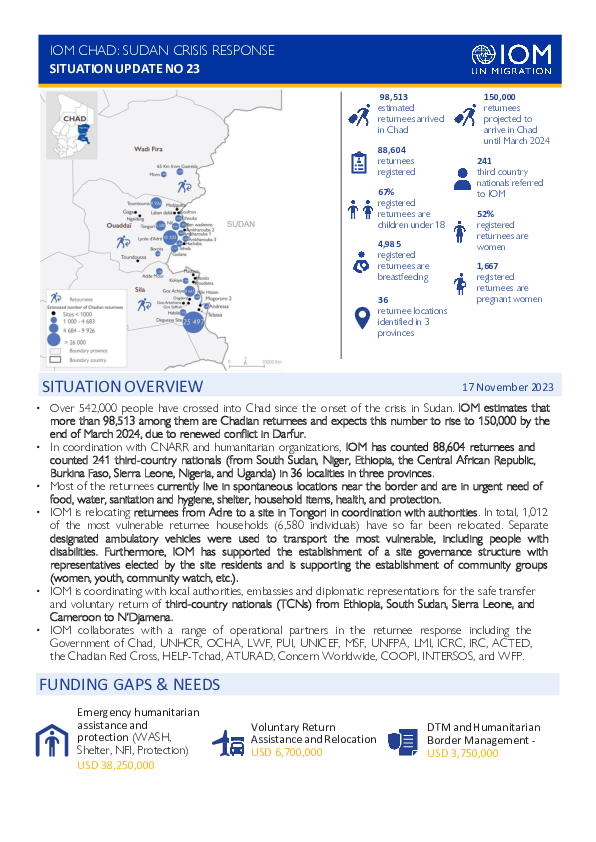
Contact
DTM Chad, dtmtchad@iom.int
Language
English
Location
Chad
Period Covered
Nov 17 2023
Nov 21 2023
Activity
- Survey
- Flow Monitoring Survey
- Flow Monitoring
- Over 542,000 people have crossed into Chad since the onset of the crisis in Sudan. IOM estimates that more than 98,513 among them are Chadian returnees and expects this number to rise to 150,000 by the end of March 2024, due to renewed conflict in Darfur.
- In coordination with CNARR and humanitarian organizations, IOM has counted 88,604 returnees and counted 241 third-country nationals (from South Sudan, Niger, Ethiopia, the Central African Republic, Burkina Faso, Sierra Leone, Nigeria, and Uganda) in 36 localities in three provinces.
- Most of the returnees currently live in spontaneous locations near the border and are in urgent need of food, water, sanitation and hygiene, shelter, household items, health, and protection.
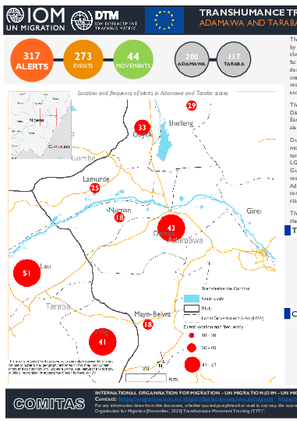
Contact
DTM Nigeria, AllUsersInDTMNigeria@iom.int
Language
English
Location
Nigeria
Period Covered
Oct 01 2023
Oct 31 2023
Activity
- Event Tracking
In October 2023, 317 alerts were reported, comprising 273 events (86%) and 44 movements (14%). The reported event alerts encompass agro-pastoral conflicts, inter and intra-community tensions, violent clashes, kidnappings for ransom, cattle rustling, and robberies, among others. Lau and Zing LGAs recorded the highest number of alerts at 21 and 16 per cent respectively. At the same time, Demsa, Guyuk, Shelleng, Lamurde, Mayo-belwa, Numan and Girei LGAs reported 15, 12, 10, 8, 7, 6, and 5 per cent respectively. Disaggregated data at the ward level suggested that Kodomti ward in Numan LGA of Adamawa state reported the highest number of alerts at the ward administrative level, accounting for 7 per cent. Additionally, the Chikila ward in Guyuk LGA of Adamawa State, and Monkin and Zing LGAs in Taraba State each reported 5 per cent of the alerts.
The reported event alerts indicated a 5 per cent instance of population displacement, while 15 per cent of the alerts resulted in casualties or injuries.
